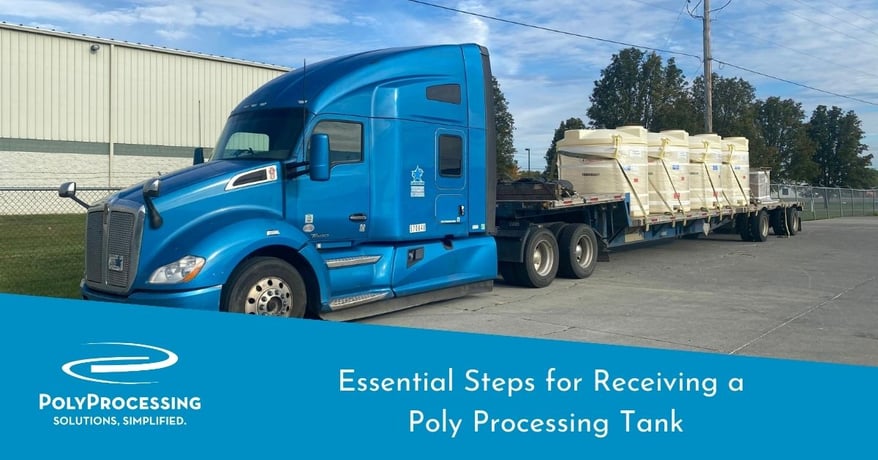Essential Steps for Receiving a Poly Processing Tank
Receiving a Poly Processing tank, whether it's for industrial, commercial, or municipal use, is a crucial process that requires careful attention to detail. Before the tank is put into service, several essential steps must be followed to ensure its safety, functionality, and readiness.

In this article, we’ll explore the key aspects of receiving a chemical storage tank and the importance of documenting any issues with the tank before the delivery truck leaves your site.
Receiving the Tank
When you receive a PPC chemical tank, it's important to conduct a thorough visual inspection.
Inspect the PPC chemical storage tank immediately upon receipt for obvious damage, defects, or missing parts and accessories. Parts and accessories are often secured in a box and shipped loose from the tank. Locate and open all packages to account for all tank parts, referring to the packing slip.
Note any damage or discrepancies on the driver’s copy and the packing slip. Have the driver initial the packing slip.
If you have any problems with receiving the tank, immediately notify your Authorized Distributor or Poly Processing Company.
If you discover any damaged or missing merchandise, report the problem within THREE (3) working days to ensure your claim. Your authorized distributor and/or Poly Processing Company can assist you with this process.
After Receiving Your Tank
It’s common to store chemical tanks for a period of time before installation. Often, loose, or boxed parts are misplaced or used for something else on site. We recommend clearly marking any loose or boxed parts for the chemical storage tank only. Store boxes in a safe location where they can be easily found and retrieved.
Crosslinked polyethylene (XLPE) tanks can sit in direct sunlight, but we recommend covering your XLPE tank with a tarp to keep it clean.
Store tanks out of high-traffic areas, including forklift traffic, so they don’t get gouged or damaged by incidental impact.
Important: IMFO™ tanks and Sloped Bottom IMFO tanks need a 4 x 4 block under the molded outlet so that it does not rest directly on the ground.
Bellows Transition Fittings
Poly Processing Company has engineered a secure yet flexible, fully contained SAFE-Tank bottom discharge called the Bellows Transition Fitting. If your tank is equipped with a transition fitting, take extra care to ensure proper alignment before sending the crane or rigging equipment away.
We have created two videos to help you understand the SAFE-Tank and the importance of setting the tank and aligning the transition fitting before the crane or rigging equipment is removed from the site.
Hydrostatic Testing
One of the most crucial steps in receiving a tank is conducting a hydrostatic test. This test determines the tank's structural integrity and helps make sure all the fittings are tightened and not leaking.
Poly Processing Company recommends a 24-hour hydro test. Essentially, the test requires filling the tank with water while monitoring for any leaks or fitting issues.
When the tank passes the hydro test, remove all test water to prevent a reaction with the chemical being stored. The chemical storage tank can then proceed to be put into service. In the unlikely event of a failed hydro test, further inspection or repairs may be required.
Documentation and Record-Keeping
Maintaining proper documentation is essential throughout the tank receiving process. Keep a detailed record of the tank's specifications, purchase orders, inspection reports, hydro test results, and any other relevant paperwork. This documentation will be very helpful to facilitate future maintenance, repairs, or inspections.
Problem-free Tank Receiving
Receiving an XLPE tank goes beyond merely accepting delivery — it involves comprehensive visual inspection, proper alignment of transition fittings, and hydro testing. By following these essential steps, you can ensure your chemical tank's safety and functionality, and minimize the risk of accidents or failures.
Remember that proper documentation and attention to detail are key to a successful tank receiving process. Stay informed, prioritize safety, and consult with Poly Processing tank experts when needed.
Poly Processing has published an Installation, Operation, and Maintenance Manual on our website. All the information in this article, as well as other topics, are covered in the IOM.
Download the Installation, Operation and Maintenance Manual.
- November 20, 2023
- Topics: Applications
About Poly Processing
Posts By Topic
Tech Talk Podcast Episodes
Subscribe By Email
Recent Posts
- Installation Tips for Chemical Storage Tanks: Site Preparation and Offloading
- Understanding pH and Chemical Concentration When Choosing a Chemical Tank
- Maximizing Fill Efficiency: Selecting the Optimal Fill Line System
- Chemical Storage Tanks: A Quick Guide for End Users
- Popular Customization Options for Chemical Storage Tanks
Tank Configurator

Find the recommended tank and system components for your chemical storage challenge.
Configure a Tank Package






